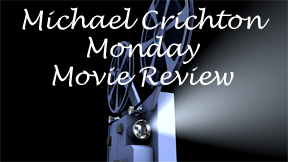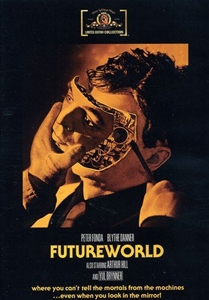Most people know HBO’s “Westworld” is based on Michael Crichton’s 1973 movie of the same name, but it’s perhaps less well-known that Seasons 2 and beyond draw from the sequel “Futureworld” (1976). Crichton – who, outside of “Jurassic Park,” eschewed doing sequels — has no part in this one, but director Richard T. Heffron and writers Mayo Simon and George Schenk faithfully continue the futurism inherent in Crichton’s concept.
Attack of the clones
Unusual for Crichton, who normally digs into technological details, “Westworld” used a lot of technobabble when showing how the engineers run the park and its robots from control rooms.
“Futureworld” has some of that – it cuts to banks of panels with flashing lightbulbs a fair amount – but this sequel gives more than a half-hearted effort at imagining how foolproof clones might be created.

“Futureworld” (1976)
Director: Richard T. Heffron
Writers: Mayo Simon, George Schenck
Stars: Peter Fonda, Blythe Danner, Arthur Hill
In the most chilling sequence, visiting reporters Chuck Browning (Peter Fonda) and Tracy “Socks” Ballard (Blythe Danner) are captured from their hotel-room beds, having been drugged, and Delos gathers up all kinds of information on them.
It’s like the check-in sequence from “The Andromeda Strain” – except without consent. (By the way, that film’s Arthur Hill is present here as seemingly kindly Delos leader Duffy.)
The spy state
Ominous shots of video cameras and technicians watching monitors presage the spy state we know so well today.
And we also get a repair room full of damaged ’bots; this might’ve been creepy at the time but now it pales in comparison to what we see on TV’s “Westworld.” Actors have gotten better at playing robots, and effects have gotten better at making it seem like the wires are truly inside the body.
Of course, “Futureworld” was made in a more primitive age of special effects. TV’s “Westworld” uses its big budget and modern tools to add verisimilitude to everything, but I don’t know if that means it delivers its points any better.
Often times, the series’ narrative complexity plays as obfuscation. I knew more or less what would happen in “Futureworld” as soon as I pressed play, but I appreciated the fairly brisk pace and I could tell the filmmakers were trying to be serious.
Of its time
Still, the film is undeniably of its time even if the ideas are forward-thinking. The fight scenes are stiffly choreographed, but Fonda and Danner – an appealing pair, even if their romance is James Bondian in its simplicity – do good work in the scenes where Chuck and Tracy are pursued by doppelgangers.
I like how our heroes use the villain’s (John Ryan as Dr. Schneider) expectations against him in the final act, also keeping viewers guessing about how this is going to end.
A “holographic” chessboard presages “Star Wars” by a year, and it’s a reminder of how “Star Wars” was such a leap forward in special effects. But it’s fun to see the primitive way the “miniatures” are done: Life-size chess pieces move on a set identical to the normal-sized gameboard.

More impressive is a computer screen showing a 3D face. And the removal of robots’ faces, revealing the computer-chip board beneath, always looks real enough.
“Futureworld” is lighter on humor than I might’ve guessed, although we get an amusing scene where Tracy attempts to seduce a control-room worker in order to get information, but he’s a robot unfazed by her wiles.
The film’s “comedy” thread follows a game-show winner (Stuart Margolin’s Harry) who enjoys the park’s sex-bots, but this stuff is obvious and it’s eventually abandoned.
“Futureworld” has enough reasons to exist outside of being a cash-grab sequel. The later TV series “Beyond Westworld” apparently is terrible, but this first follow-up is respectful of what Crichton created, and it did not go unnoticed by the writers of HBO’s “Westworld.”

